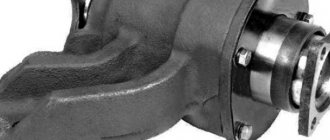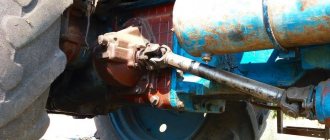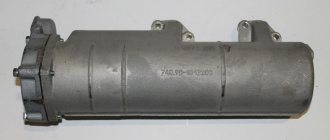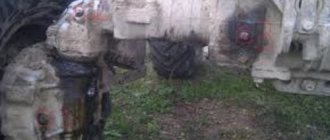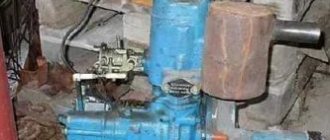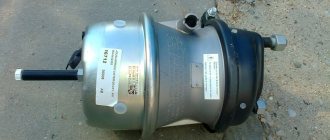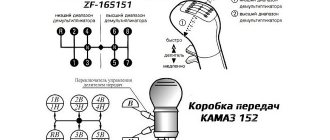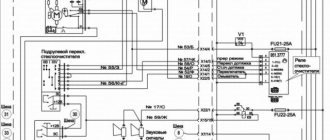Intermediate support MTZ-82. Design, diagram, and necessary information for repairing the intermediate support of the cardan drive of the MTZ-82 tractor. Adjustment and maintenance of the cardan drive.
The role of torque conductor to the front drive axle, directly from the transfer case, is performed by the cardan drive. The main drive parts are shafts of the same name. The above parts are connected by a shaft support, called an intermediate one. Structurally and in size, cardan shafts do not have any fundamental differences from each other. The names (front and rear) are given solely by the location of the shafts.
Helpful information
Contents of the article:
Introduction
The MTZ-82 tractor (“Belarus”) is a reliable machine with the following practical advantages:
- permeability;
- maneuverability (due to small dimensions);
- controllability;
- power sufficient to perform a wide range of work, from banal transportation of goods to specialized tasks.
The tractor has found application in various industries: from agriculture to repair and construction. The front axle of the MTZ-82 plays an important role in its performance. Thanks to this unit, a comfortable level of ground clearance and a wide variety of track widths are achieved. The front axle of the MTZ-82 tractor itself is designed to transmit torque. It is carried out from the electric motor to the wheels.
General technical information
The MTZ-82 front drive axle has a rather complex device. Its key elements:
- Central gear. The design includes a set of conical gears with spiral teeth. With their help, torque is intensified.
- Differential. This part is equipped with an automatic self-locking function. It consists of an axle, two satellites and two gears, one of which is driven, the other is driven.
- Wheel reducer. It is made in the form of a cone, and it plays a key role in transmitting torque. This communication is carried out through special telescopic connections, which ensure that the track adjustment process of both the front and rear wheels is synchronized. The presence of gears helps to increase the angle of rotation.
- Beam. It contains important elements, in particular the differential and final drive.
In addition to the above, the MTZ-82 front axle includes a flange mechanism, bearings, cuffs, seal rings, nuts, cups, etc. The friction block consists of a breather, a support, and a worm device. There are racks - front and rear, the width of which is 2.2 and 2.4 cm, respectively.
Functioning of individual elements
The MTZ-82 front axle gearbox has a cylindrical shape. Its basic design includes a set of special disks. In the center there is a conical plate that closes on the shaft, and there is also a gasket there. A group of bearings is installed on the lower and upper sides of the housing.
The breather maintains operating pressure. Its function extends to the area where the main gear and beam are located. On the front axle of the MTZ-82 tractor, it is installed in conjunction with a long tube connected to the gearbox. This unit operates in a high-load area, so its housing is manufactured with a high degree of protection. The functioning of the breather involves three disks, under which threaded linings are located. There are wide clips at the top of the assembly.
The operation of the gear depends on the vertical shaft of the front axle. It is installed on the gearbox and secured with special, durable screws, since it operates at high speeds. The part is equipped with a flange equipped with an adjusting adapter. A small glass is also installed on the unit, and in its upper part there is an overlay. Dismantling and installation of the vertical shaft is carried out quite quickly.
Node maintenance
Intermediate support maintenance measures:
- Check the presence of lubricant in the housing at the level of the inspection hole, as well as the lubrication of the cardan joints of the drive every 120 hours of operation
- Check that the assembly is securely tightened
- Check the reliability of the connection of the flanges of the drive shafts with the transfer case, suspension support and final drive of the front axle
- Pay attention to the appearance of lateral play in the bearings of the crosspieces. Timely replacement of crosspiece bearings will prevent serious damage to the drive.
- Based on the nature of the work performed using the front drive axle, pay attention to the moment the support clutch is activated. If necessary, tighten the coupling nut.
The filling volume of the unit is 0.15 liters. The transmission lubricant used for the support is TAp-15V, TSp-10, TSp-15K, TAD-17 GOST 2365-79. For the convenience of filling the unit with lubricant, many practitioners additionally equip the body with a grease dispenser with a spring-loaded shut-off ball valve.
Adjustment and care
The main element of the intermediate support that needs adjustment is the safety clutch. It is adjusted by tightening the rear shank nut. The coupling must provide torque transmission from 400 to 800 Nm. In case of deviations from the norm, the components and parts of the transmission will experience increased load and rapid wear, even to the point of failure. It is also necessary to periodically check the lateral play in the driveshaft bearings. The appearance of play may indicate an imbalance of the cardans. You should ensure that there is lubrication in the support and that all connections are secure.
The intermediate support for the MTZ 82 cardan shaft is a reliable and load-resistant unit that rarely fails with proper and timely maintenance.
Causes of support malfunctions
Often, insufficient pressure on the clutch discs provokes operation and slipping at weak forces, which is accompanied by overheating of the unit. The clamping force of the promo-pore cotter pin nut can decrease as a result of natural operating wear of the coupling discs, as well as when the elasticity of the spring disc washers, which exert their force on the coupling discs, decreases. When slipping occurs as a result of friction, the oil boils in the support body and the excess pressure of the expanded heated lubricant squeezes out the sealing seals. After loss of lubrication, the unit begins to run dry, subjecting the structural parts to rapid wear. If the control subsequently ignores the condition of the unit, operation without lubrication can lead to destruction of parts and jamming of the mechanism, as well as emergency breakage of the support housing mounting bracket.
An additional factor influencing the operation of the intermediate support is the reliability of the tightening of the assembly bracket to the tractor clutch housing. Another important factor is the balancing of the drive shafts and the condition of the crosspiece bearings.
Repair and adjustment
If a malfunction in the operation of the support is detected, it is recommended to disable the front axle drive. In compliance with safety regulations, inspect the unit and check the lubricant level in the housing. If there is a working oil level and there are no unacceptable backlashes on the seats of the connecting flanges of the unit, tighten the adjusting nut 2 with a force of 40 N.m (4 kgf.m.) to achieve an increase in the clutch actuation force to 400-800 N.m (40-80 kgf. .m).
If the adjustment does not give a positive effect in the operation of the unit, it is dismantled to inspect the unit and troubleshoot problems. When performing an inspection, if the assembly parts are in normal condition, the reason for the lack of the set clutch actuation force is the wear of the friction discs. Fix the problem by additionally installing a pair of working disks and, if necessary, change the spring disc washers. Thus, the wear thickness of the discs is compensated and the required force when tightening the adjusting nut is restored.
Also, during subsequent repairs, it must be taken into account that due to heating of the oil, rubber seals lose their elasticity and, although visually intact, do not perform their sealing function.
The procedure for assembling the intermediate support
Before starting assembly, make sure that there is no unacceptable wear on the parts' seats. The presence of ellipse in the seating areas of the intermediate sleeve, support sleeve, sliding and connecting flanges will cause imbalance during rotation and will not allow the seals to fit tightly in the assembly structure.
The assembly of the unit is carried out in the following order:
- seating the oil seal in the support body
- seating bearings on intermediate sleeve
- fit into the intermediate sleeve of the supporting sleeve of the connecting flange
- Fitting the bushing with bearings into the unit body, assembling the coupling parts onto the shaft
- installing the coupling on the internal splines of the intermediate sleeve
- installing a sliding flange on the intermediate sleeve splines
- installation of seals on the side of the connecting flange
- installing sealing gaskets under the unit covers and tightening them
- adjusting tightening of the coupling cotter pin nut with a force of 40 N.m
Intermediate support device
Often in practice the described unit is called “promopore” or “suspended support”, “suspended support”, and also in common parlance “piglet”. A separate cast-iron housing of the assembly is attached with a bracket to the lower part of the clutch housing. The mount is installed on two pins 1 and tightened with three fastening bolts. The length of the bolts should not exceed 40 mm, as an increased size can lead to obstruction of rotation of the engine flywheel.
Diagram of the intermediate support MTZ 82
In the support housing 6, on two ball bearings 8 (No. 6015), a connecting tubular sleeve 10 , the internal splines of which connect the drive intermediate drive shaft to the front driven drive shaft through a friction safety clutch. The coupling is a splined shaft 12 13 14 assembled on it , which are installed in pairs. The driving disks 13 with teeth along the inner diameter engage with the splines of the coupling shaft 12 , and the driven disks 14 with external teeth engage with the splines of the connecting sleeve 10 . A set of disks is installed on a spacer sleeve 7 ; on the reverse side, the disks are pressed by spherical spring washers 15 , which create a constant force on the connected disks to transmit rotation. The structure is secured by a coupling nut 2 installed through the mounting flange 3 of the intermediate propeller shaft. The degree of tightening of the nuts regulates the force of the spring washers to press the clutch disks against each other and, accordingly, the actuation force of the clutch. The rotation received from the coupling to the intermediate sleeve is transmitted through a splined connection to the sliding flange 11 connected by a cardan to the FDA main drive.
In a standard situation, the clutch shaft and intermediate sleeve work as one whole part, transmitting rotation without changing frequency to the front drive axle. When sudden loads occur, the disks, reacting to jerks, rotate relative to each other, overcoming the friction force between the disks created by the degree of tightening of the coupling nut 2 . In this case, the shaft rotation speed is not completely transmitted to the intermediate sleeve. In this way, the supplied peak power pulses are damped.
Related Posts
Alteration of the intermediate support on the MTZ-82.
- Author: Dmitry Lomagin
- March 01, 2020
- 33 comments
Hello. Is there anyone who remade the piglet on MTZ82, maybe someone did it directly?
What to do? I installed a new intermediate support on the MTZ 82, but it gets so hot that my hand can’t stand it. There is oil.
- Author: Oleg Vinokurov(admin)
- 14 May 12:55
Question from a subscriber: Hello everyone. Guys, can anyone tell me what to do? I installed a new intermediate support on the MTZ 82, but it gets so hot that my hand can’t stand it. There is oil.
I installed a new cardan support. Is there a certain tightening torque (because after tightening the support started to heat up)? Mtz 82
- Author: Alexey Revega
- 12 April 18:02
The guys installed a new universal joint support. It worked for a month and failed. Today I unscrewed the universal joint and slightly tightened the nut (not much), as I understand it, there is a certain tightening torque (because after tightening the support began to heat up) So who knows this tightening torque? Mtz 82
MTZ 82. Why does noise appear in 9th gear when you drive, up or down, without the front parking brake turned on, when you turn it on it goes away?
- Author: Alexey Ilyin
- March 17 11:00
Tell me, please. Can't find a reason. MTZ 82. In 9th gear when you drive, up or down, without the front parking gear on, noise appears, when you turn it on it goes away. The cardan shafts, transfer case, outboard are new, bearings on the shafts are standard, onboard bearings are new. I don’t understand what could be the reason?
Possible faults
The following element malfunctions are probable:
- Possible heating. It is recommended to disable the front axle whenever it is not in use. It is also important to choose the right tires for the front wheels to optimize the load.
- A sharp sound (squealing), especially when working with front attachments. Indicates that the support is overloaded and can be corrected by replacing the disks or adjusting the nut.
- The front axle does not work. This often happens in cases where changes were made to the drive design that were not provided for by the manufacturer, for example, a simple connecting coupling was assembled from an adjusting coupling. This greatly simplifies maintenance, but does not protect against overload and may require replacement of the support or other components.
